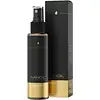What's inside
What's inside
 Key Ingredients
Key Ingredients

No key ingredients
 Benefits
Benefits

 Concerns
Concerns

 Ingredients Side-by-side
Ingredients Side-by-side

Water
Skin ConditioningCyclopentasiloxane
EmollientCyclohexasiloxane
EmollientPhenyl Trimethicone
Skin ConditioningDimethiconol
EmollientPolyquaternium-16
Panthenol
Skin ConditioningPropylene Glycol
HumectantHydrolyzed Wheat Protein
Skin ConditioningHydrolyzed Silk
HumectantPEG-12 Dimethicone
Skin ConditioningHydroxypropyltrimonium Hydrolyzed Wheat Protein
Skin ConditioningLactic Acid
BufferingCetrimonium Chloride
AntimicrobialParfum
MaskingBenzophenone-4
UV AbsorberCI 16185
Cosmetic ColorantBenzyl Salicylate
PerfumingAmyl Cinnamal
PerfumingLimonene
PerfumingCitronellol
PerfumingLinalool
PerfumingGeraniol
PerfumingWater, Cyclopentasiloxane, Cyclohexasiloxane, Phenyl Trimethicone, Dimethiconol, Polyquaternium-16, Panthenol, Propylene Glycol, Hydrolyzed Wheat Protein, Hydrolyzed Silk, PEG-12 Dimethicone, Hydroxypropyltrimonium Hydrolyzed Wheat Protein, Lactic Acid, Cetrimonium Chloride, Parfum, Benzophenone-4, CI 16185, Benzyl Salicylate, Amyl Cinnamal, Limonene, Citronellol, Linalool, Geraniol
Water
Skin ConditioningDipropylene Glycol
HumectantPolysilicone-29
Silicone Quaternium-18
EmollientArgania Spinosa Kernel Oil
EmollientArtocarpus Heterophyllus Fruit Extract
Skin ConditioningAmaranthus Caudatus Seed Extract
Skin ConditioningParfum
MaskingPolysorbate 20
EmulsifyingTrideceth-12
EmulsifyingMethylpropanediol
SolventTrideceth-6
EmulsifyingCaprylyl Glycol
EmollientGlycolic Acid
BufferingPolyquaternium-80
CleansingCitric Acid
BufferingC12-13 Pareth-9
EmulsifyingHydrolyzed Quinoa
Skin ConditioningSodium PCA
HumectantSodium Lactate
BufferingDidecyldimonium Chloride
EmulsifyingArginine
MaskingAspartic Acid
MaskingPotassium Hydroxide
BufferingPCA
HumectantLactobacillus Ferment
Skin ConditioningGlycine
BufferingAlanine
MaskingAlgin
MaskingCaprylic/Capric Triglyceride
MaskingChitosan
Serine
MaskingValine
MaskingIsoleucine
Skin ConditioningProline
Skin ConditioningThreonine
Histidine
HumectantPhenylalanine
MaskingPhenoxyethanol
PreservativeSodium Benzoate
MaskingPotassium Sorbate
PreservativeBenzyl Alcohol
PerfumingLinalool
PerfumingAlpha-Isomethyl Ionone
PerfumingWater, Dipropylene Glycol, Polysilicone-29, Silicone Quaternium-18, Argania Spinosa Kernel Oil, Artocarpus Heterophyllus Fruit Extract, Amaranthus Caudatus Seed Extract, Parfum, Polysorbate 20, Trideceth-12, Methylpropanediol, Trideceth-6, Caprylyl Glycol, Glycolic Acid, Polyquaternium-80, Citric Acid, C12-13 Pareth-9, Hydrolyzed Quinoa, Sodium PCA, Sodium Lactate, Didecyldimonium Chloride, Arginine, Aspartic Acid, Potassium Hydroxide, PCA, Lactobacillus Ferment, Glycine, Alanine, Algin, Caprylic/Capric Triglyceride, Chitosan, Serine, Valine, Isoleucine, Proline, Threonine, Histidine, Phenylalanine, Phenoxyethanol, Sodium Benzoate, Potassium Sorbate, Benzyl Alcohol, Linalool, Alpha-Isomethyl Ionone
Ingredients Explained
These ingredients are found in both products.
Ingredients higher up in an ingredient list are typically present in a larger amount.
Linalool is a fragrance and helps add scent to products. It's derived from common plants such as cinnamon, mint, citrus, and lavender.
Like Limonene, this ingredient oxidizes when exposed to air. Oxidized linalool can cause allergies and skin sensitivity.
This ingredient has a scent that is floral, spicy tropical, and citrus-like.
Learn more about LinaloolParfum is a catch-all term for an ingredient or more that is used to give a scent to products.
Also called "fragrance", this ingredient can be a blend of hundreds of chemicals or plant oils. This means every product with "fragrance" or "parfum" in the ingredients list is a different mixture.
For instance, Habanolide is a proprietary trade name for a specific aroma chemical. When used as a fragrance ingredient in cosmetics, most aroma chemicals fall under the broad labeling category of “FRAGRANCE” or “PARFUM” according to EU and US regulations.
The term 'parfum' or 'fragrance' is not regulated in many countries. In many cases, it is up to the brand to define this term.
For instance, many brands choose to label themselves as "fragrance-free" because they are not using synthetic fragrances. However, their products may still contain ingredients such as essential oils that are considered a fragrance by INCI standards.
One example is Calendula flower extract. Calendula is an essential oil that still imparts a scent or 'fragrance'.
Depending on the blend, the ingredients in the mixture can cause allergies and sensitivities on the skin. Some ingredients that are known EU allergens include linalool and citronellol.
Parfum can also be used to mask or cover an unpleasant scent.
The bottom line is: not all fragrances/parfum/ingredients are created equally. If you are worried about fragrances, we recommend taking a closer look at an ingredient. And of course, we always recommend speaking with a professional.
Learn more about ParfumWater. It's the most common cosmetic ingredient of all. You'll usually see it at the top of ingredient lists, meaning that it makes up the largest part of the product.
So why is it so popular? Water most often acts as a solvent - this means that it helps dissolve other ingredients into the formulation.
You'll also recognize water as that liquid we all need to stay alive. If you see this, drink a glass of water. Stay hydrated!
Learn more about Water